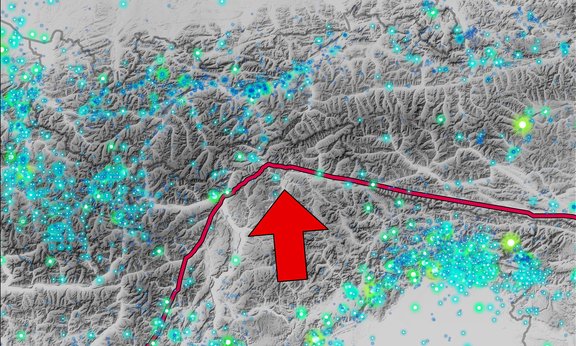Have you ever felt an earthquake, did it frighten you? The Austrian Earthquake Service of the Central Institute for Meteorology and Geodynamics (ZAMG) registers about 40 earthquakes per year, which are felt by people in Austria. Luckily, strong earthquakes are rare in most parts of the Eastern Alps. “ Even weak quakes can be used to study what happens in the Earth’s crust,” Franz Reiter knows. In his doctoral thesis, and together with seismologists, he investigated active mountain building processes in the Eastern Alps. The research group could show that the Dolomites indenter, a spur reaching into the Eastern Alps, influences the stress field and earthquake activity in its surroundings. Their results were recently published in the renowned journal “Tectonics”.
Earthquake waves
Tectonic earthquakes below the Alps are caused by rupturing and displacement in the Earth’s crust. Here, most seismic events origin in a depth between 5 and 20 kilometers. Rupture size is commonly smaller than one square kilometer and displacements range in the centimeter scale or below. Despite the small dimensions, all earthquakes generate a characteristic body wave pattern, with frequencies commonly reaching the hearing range. “If we record seismic waves at many earthquake stations around the epicenter, we are able to reconstruct the orientation of rupture planes and the movement of the broken crustal segments relative to each other,” Reiter says. A progressive densification of the station network has made such investigations possible down to a magnitude of about 2.5. “Most of these events are just above the threshold to be felt,” Reiter explains.
Pressure against the Alps
Indications for earthquake activity reach from today until far in the geological past, when the microcontinent Adria – a northern continuation of the African plate – collided with Europe. After this collision, sheared fragments of both continents were stacked onto the European plate. The Alpine orogen came into being. A central part of the Eastern Alps moved laterally towards the east. Sideward movements are also responsible for the characteristic shape of the Dolomites indenter (delimited by red lines in the Figure above). “From GPS surveying data we know that Adria is still moving toward the north, relative to Europe,” Reiter says. “The results of our earthquake computations show that a portion of this north-directed movement of Adria causes thrust earthquakes, which indicate ongoing crustal stacking below the central Inn valley and neighboring areas. Here we could observe a previously unknown, enhanced thrust activity in our data set.” Closer to the indenter, the earthquakes indicate lateral movements and stretching of the orogenic crust, oblique to this boundary. Reiter is convinced that the results are a major contribution to the understanding of the orogenic structure and active mountain building processes. “Our findings are a valuable base for related fields of science, such as the investigation of historical earthquakes and prehistoric rock falls, and earthquake risk research.”
Links
- Reiter, F., Freudenthaler, C., Hausmann, H., Ortner, H., Lenhardt, W., & Brandner, R. (2018). Active seismotectonic deformation north of the Dolomites indenter, Eastern Alps. Tectonics
- Innsbruck Tectonics Research Group
- “Tyrol on Shaky Slopes”. Projekt zur paläoseismologischen Forschung mit Hilfe von Seesedimenten (Institut für Geologie, Universität Innsbruck
- ARMONIA (INTERREG V Project)
- HAREIA (German)

